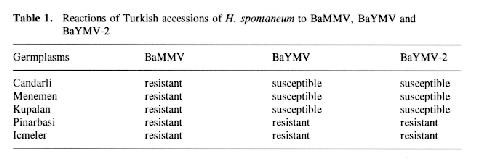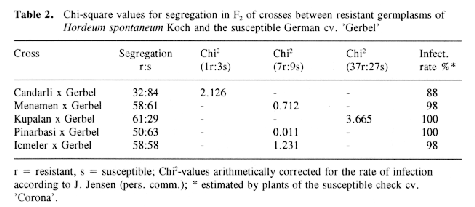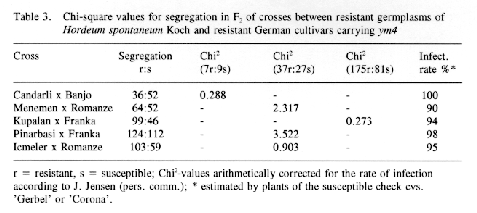

Barley yellow mosaic disease in Western Europe is caused by a complex of at least three viruses or virus strains, i.e. barley mild mosaic virus (BaMMV), barley yellow mosaic virus (BaYMV) and BaYMV-2 (Huth & Adams, 1990; Huth, 1990). In this area it is one of the most important diseases of winter barley. Resistance of cultivars released in Germany is presumed to be due to an identical recessive gene, ym4, which is effective against BaMMV and BaYMV but not against BaYMV-2. The gene ym4 was located on the long arm of chromosome three by means of trisomic analysis (Kaiser & Friedt, 1989, 1992) and RFLP-analysis (Graner & Bauer, 1993). Intensive screening programmes and F2-segregation analyses were carried out in order to identify varieties resistant to all of the yellow mosaic inducing viruses and carrying genes different from ym4. In these studies a large number of H. vulgare varieties resistant to BaMMV, BaYMV and BaYMV-2 and carrying BaMMV-resistance genes different from ym4 have been identified (Götz & Friedt, 1993; Ordon & Friedt, 1993). In order to gain information whether resistance to the yellow mosaic inducing viruses is present in the wild progenitor of cultivated barley, twelve lines of H. spontaneum Koch collected at different sites of Western Turkey were screened for their reactions to BaMMV, BaYMV and BaYMV-2.
H. spontaneum germplasms were screened for BaMMV-reaction by mechanical spray-gun inoculation in the greenhouse (cf. Friedt, 1983; Kaiser & Friedt, 1989), for BaMMV/BaYMVreaction in an infested field at Bel Inhausen/Gil serberg (Northern Hesse) and for BaYMV-2reaction at Schladen (Lower Saxony). Reactions were estimated by DAS-ELISA according to Casper & Meyer (1981) using BaMMV/BaY MV-ant i sera kindly provided by Dr. W. Huth, Federal Biological Research Center, Braunschweig, Germany. Plants resistant to BaMMV were crossed to the susceptible German winter barley cv. 'Gerbel' and the progeny of these crosses were analyzed in F1 and F2-generation in order to study the mode of inheritance of resistance to this virus. Genetic analysis of resistance to the yellow mosaic inducing viruses is still limited to BaMMV because this virus is mechanically transmissible efficiently - in contrast to BaYMV and BaYMV-2. Furthermore, resistant H. spontaneum lines were crossed to resistant German cultivars carrying ym4, like 'Banjo', 'Romanze' and 'Franka', to investigate whether BaMMVresistance of these lines is determined by genes different from or allelic to ym4.
Seven out of twelve germplasms tested for their reaction to the soil-borne mosaic inducing viruses were found to be susceptible to BaMMV, BaYMV and BaYMV-2. However, the other five accessions turned out to be resistant at least against BaMMV. While 'Candarli', 'Menemen' and 'Kupalan' are resistant to BaMMV only, two lines ('Pinarbasi' and 'Icmeler') are fully resistant to BaMMV and BaYMV, as well as to BaYMV-2 (Table 1).
F1-plants of all crosses between the germplasms mentioned in Table I and the susceptible cv. 'Gerbel' were all susceptible to BaMMV. From these results it can be concluded that BaMMV-resistance of the H. spontaneum lines tested is inherited entirely recessively. F2-segregation analyses confirmed this assumption and revealed that BaMMV-res i stance of 'Candarli' is inherited by a single recessive gene (Ir : 3s). The resistance of 'Menemen', 'Pinarbasi' and 'Icemeler' is obviously due to two independent genes as indicated by the good fit to an expected segregation ratio of 7r : 9s (Table 2). In the cross 'Kupalan' × 'Gerbel' a good fit to an expected segregation ratio of 37r : 27s was found which hints to the presence of three recessive genes conferring resistance to BaMMV in 'Kupalan'. Agreement between observed segregation and theoretical expectation was assumed, if the chi-square value was smaller than 3.841 (P=0.05).


Furthermore, crosses between resistant H. spontaneum accessions and resistant German cultivars revealed that all of the germplasms carry genes different from ym4 (Table 3). For all combinations tested a good fit between the observed and the expected segregation ratio was observed (Chi2<3.841) while in the case of allel isin between genes present in H. spontaneum and ym4 no susceptible plants were expected in F2.
The results on reactions of Turkish H. spontaneum germplasms to the soil-borne mosaic inducing viruses indicate that resistance is present in H. spontaneum and that BaMMV resistance of these germplasms is inherited entirely recessively, Just like in H. vulgare. Furthermore, all of the lines tested carry genes different from ym4. Therefore, H. spontaneum is a valuable genetic resource for resistance to the barley yellow mosaic virus complex, as for resistance to powdery mildew (Erysiphe graminis) or Puccinia hordei (Moseman et al., 1983, 1990; Nevo et al., 1986; Jahoor & Fischbeck, 1987).

References:
Casper, R., and S. Meyer. 1981. Die Anwendung des ELISA- Verfahrens zurn Nachveis pflanzenpathogener Viren. Nachrichtenbl. Deut. Ptlanzenschutzd. 33: 49-54.
Friedt, W. 1983. Mechanical transmission of soil-borne barley yellow mosaic virus. Phytopathol. Z. 106: 16-22.
Götz, R., and W. Friedt. 1993. Resistance to the barley yellow mosaic virus complex - Differential genotypic reactions and genetics of BaMMV-resistance of barley (Hordeum vulgare L.). Plant Breed. I 11: 125 -13 1.
Graner, A., and E. Bauer. 1993. RFLP mapping of the ym4 virus resistance gene in barley. Theor. Appl. Genet. 86: 689-693.
Huth, W. 1990. The yellow mosaic inducing viruses of barley in Germany. Proc., Ist Symp. Intern. Working Group Plant Viruses with Fungal Vectors, Braunschweig, Germany, August 21-24. 1990, 113-115.
Huth, W., and M. J. Adams. 1990. Barley yellow mosaic virus (BaYMV) and BaYMV-M: two different viruses. Intervirology 31: 38-42.
Jahoor, A., and G. Fischbeck. 1987. Genetical studies of resistance to powdery mildew in barley linies derived from Hordeum spontaneum collected in Israel, Plant Breeding 99:265-273.
Kaiser, R., and W. Friedt. 1989. Chromosomal location of resistance to barley yellow mosaic virus in German winter-barley identified by trisomic analysis. Theor. Appl. Genet. 77:241-245.
Kaiser, R., and W. Friedt. 1992. Gene for resistance to barley mild mosaic virus in German winter-barley located on Chromosome 3L. Plant Breed. 108: 169-172.
Moseman, J.G., E. Nevo, and M.A. El Morshidy. 1990. Reaction of Hordeum spontaneum to infection with two cultures of Puccinia hordei from Israel and United States. Euphytica 49: 169-175.
Moseman, J.G., E. Nevo, and D. Zohary. 1983. Resistance of Hordeum spontaneum collected in Israel to infection with Erysiphe graminis hordei. Crop Sci. 23: 1115-1120.
Nevo, E., D. Zohary, A. Beiles, D. Kaplan, and N. Storch. 1986. Genetic diversity and enviromental associations of wild barley, Hordeum spontaneum, in Turkey. Genetica 68: 203-213.
Ordon, F., and W. Friedt. 1993. Mode of inheritance and genetic diversity of BaMMV resistance of exotic barley germplasms carrying genes different from ym4. Theor. Appl. Genet. 86: 229-233.